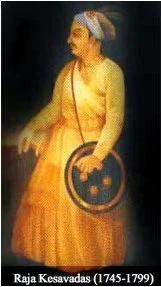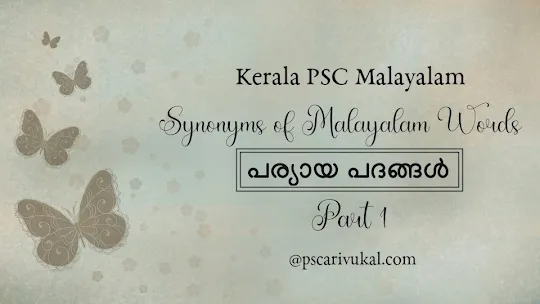Alappuzha (formerly Alleppey) was a part of the Kottayam & Kollam districts. It is a quaint little place that lies on a narrow land spit between the Arabian Sea and Vembanad Lake.
The name 'Alappuzha' is supposedly derived from the old Tamil word 'Alam' meaning marshy land and 'Puzha' meaning rivers. During the British Raj, the district was commonly known as "Alleppey."
But in 1990, the name of the district Alleppey was officially changed to Alappuzha and that of the town was changed in 2012.
We attempted to include all previous year and potential PSC questions about the district of 'Alappuzha' in one post. Hopefully, this will come in handy for the upcoming PSC exams.
History
Several inscriptions and artifacts describing the glorious past of Alappuzha have been discovered in and around the district.
One of the many artifacts is the two stone inscriptions of the Kaviyoor temple of the year 1050 AD. The Kandiyur Sasana of 946 AD, is a 123-year-old memorial of the temple that was built in the year 823 AD.
Similarly, another inscription recovered is the Sasana of Eravi Keralavarman of 393 AD. There are two more unrecorded inscriptions of Srivallabhan Kotha who supposedly ruled Venad at the end of the 10th century in the Thiruvandoor temple.
The Kuttanad region of ancient Alappuzha is considered as the primary seat of the first Chera dynasty. The district flourished under the rule of the Cheras, who were called ‘Kuttuvans’, hence the name ‘Kuttanad.’
Alappuzha town of the modern era was designed by Diwan of Travancore Raja Kesavadas in 1762 as a port city and he invited merchants from all over India for conducting trade in Alappuzha.
In 1816, the Church Missionary Society (CMS) set up its local headquarters in Alleppey and three years later the first Anglican Church was built. Later in 1859, coir factories started running along with the ports and canals for coir transport making Alappuzha the commercial hub of Kerala.
Alappuzha of latter years became a cradle for Communism. One of the main reasons for the massive growth of Communism was due to the comparatively poor public administration, leaving common man under the exploitation of rich feudal lords.
The commercial importance of Alappuzha began to decline with the development of Cochin into a major port in the late 1920s.
In the latter years after the independence, Alleppey became the epicenter of Land reforms as it was the home town of Kerala's first revenue minister, K.R. Gowri of Kerala's first Communist Government.
When the Pathanamthitta district was formed on 29 October 1982, along with parts of Kollam and Idukki, a part of Alappuzha was transferred ie, the whole of Thiruvalla taluk and a part of Chengannur and Mavelikkara taluks.
Nowadays Alappuzha became a popular tourist destination with its scenic beauty, beaches, boat races, and backwaters.
Basic Facts About Alappuzha
- Formed on –17 August 1957.
- Architect/Founder/Designer – Raja Kesavadas (Diwan of Travancore).
- Smallest District in Kerala.
- The second-largest producer of Paddy in Kerala.
- Second-most densely populated District in Kerala.
- Taluks – 6.
- Cherthala, Ambalappuzha, Kuttanad, Karthikappally, Chengannur & Mavelikkara.
- Taluk of Alappuzha with the longest coastline in Kerala– Cherthala.
- District with
- Second longest Coastline (82 km).
- Most no. of Coir Industries.
- Most no. of Cottage Industries.
- Paddy Cultivation below sea level (Kuttanad lies 0.5 m to 1.5 m below sea level).
- District without mountains.
- No. of Assembly Constituencies – 9.
- No. of Lok Sabha Constituencies – 2.
- Only reserve forest in Alappuzha – Veeyapuram (14.5 acres, 2013).
- Rivers – Manimala river, Achan Kovil river, Pamba river.
- Lakes – Vembanad Lake.
- Vembanad Lake is the largest lake in Kerala.
- Thanneermukkam bund & Thottappally Spillway.
- Famous Beaches – Purakkad, Thumboli & Thaikkal.
- Cultural Capital of Alappuzha – Ambalappuzha.
- Famous Temples – Mannarasala Snake Temple, Ambalapuzha Sree Krishna Swami Temple, Haripad Subrahmanya Swamy Temple, Chakkulathukavu, Chettikulangara Devi Temple, Kandiyoor Mahadeva Temple (approx. 2000 years old).
- Major Festivals –
- Kumba Bharani – Chettikulangara Bhagavathy Temple.
- Panthrandu Vilakku – Ochira Parabrahma Temple.
- Famous Islands – Pathiramanal island, Perumbalam island, Kakkathuruth.
- Famous Places –
- Kumarakodi (Pallana, resting place of Kumaranasan).
- Pandavan Para (Chengannur).
- St. George Shrine (Edathua), a famous Christian pilgrimage center.
- Kokkothamangalam Church (founded by St. Thomas Apostle).
- Arthinkal St. Andrews Church (established by Portuguese missionaries in 1951).
- Krishnapuram Palace & Museum, Kayamkulam.
- Built by Anizham Thirunal Marthanda Varma
- Gajendra Moksham, famous Mural painting in Krishnapuram Palace.
- Nooranad, Pakshi gramam of Kerala.
- Thakazhi Museum.
- Kunjan Nambiar Memorial (Ambalappuzha).
- Purakkad, which got fame through the celebrated novel 'Chemmeen.'
- Old Capital of Chempakassery Kingdom (Ambalappuzha).
- Originated from Alappuzha – Velakali & Ottamthullal (Ambalappuzha), Vanchipattu
- Karumadikuttan, a black granite statue of Lord Buddha was found in Karumadi near Alappuzha indicating the influence of Buddhism in ancient Kerala.
- Sree Moolavasam – Oldest Buddhist religious center in Kerala.
- Tourist Spots – Kumarakom, Saradha Mandiram (residence of Kerala Panini).
- Transport:
- Road – National Highway 66.
- Water – National Waterway 3.
Alappuzha in Ancient Literature
The works of Pliny and Ptolemy of the first and second centuries has made many references to places like Purakkad (Barace) in their classical works. During the Middle Ages, it is believed that Alappuzha had trade relations with ancient Greece and Rome.
Unnineeli Sandesam, one of the oldest literary works in the Malayalam language provides much insight into the geography of Alappuzha at that time.
The author of the famous literary work ‘Ascharya Choodamani’ (a Sanskrit drama), Sakthibhadra, (a famous scholar & contemporary of Sri Sankaracharya) belonged to Chengannur gramam.
Ancient names of Places in Alappuzha
- 'Barace' – Purakkad.
- ‘Bettimani’ – Karthikapally.
- 'Karappuram' – Cherthala.
- 'Odanadu' – Kayamkulam.
Epithets of Alappuzha
- ‘Venice of the East’ (by Lord Curzon).
- ‘Netherlands of Kerala’ – Kuttanad.
- 'Holland of Kerala' – Kuttanad.
- ‘Gift of Pamba’ – Kuttanad.
- 'Rice bowl of Kerala' – Kuttanad.
- ‘Bird Village of Kerala' – Nooranad.
- ‘Mural Pagoda’ – Krishnapuram Palace.
- ‘Mayoora Santheshathinte Nadu’ – Haripad.
- 'Dwaraka of the South' – Ambalapuzha Sree Krishna Swami Temple.
- 'Dakshina Palani' – Haripad Subrahmanya Swamy Temple.
Firsts of Alappuzha
- First Post Office (Anchalappees) in Kerala (1857).
- First Coir Factory in Kerala – Darragh Smail & Co. Ltd (1859).
- First Coir Village in Kerala – Vayalar.
- First Film Studio in Kerala – Udaya.
- First Siddha village in India – Chandiroor.
- First Seafood Park in Kerala – Aroor.
- First 100% literate Village in Kerala – Nedumudi.
- First Cartoon Museum in India – Krishnapuram, Kayamkulam.
- First Grama Panchayat to win Swaraj Trophy – Kanjikuzhy (1995-96).
- First Labour Organization/Trade Union in Kerala – Travancore Labour Association (1922).
- First Naphtha based Thermal power plant, Rajiv Gandhi Combined Cycle Power Plant of Kerala – Kayamkulam.
- First Lighthouse along the Western Coast of India – Alappuzha Lighthouse.
- Appeared on Indian Postal Stamp in 2012.
- First Solar-powered ferry (2016) and the largest solar-powered boat in India.
- Vaikkom-Thavanakkadavu (Boat name: Aditya).
- First ITBP (Indo-Tibetan Border Police) unit in Kerala.
- First Floating Flying squad of Kerala.
- First Cyclone Shelter in Kerala – Mararikulam.
- First Labour Movement Museum in India – Alappuzha.
- First Floating Bridge in Kerala.
Punnapra Vayalar Rebellion
Communist Party members were killed by the army of Diwan, 200 people at Punnapra in 1946.
📝 Read More: Punnapra Vayalar Rebellion.
Famous Personalities of Alappuzha
- Anizham Thirunal Marthanda Varma – Maker of Modern Travancore.
- The famous writer Thakazhi Sivasankara Pillai is known as Kuttanad Inte Kadhakaran.
- Resting place of Thakazhi Sivasankara Pillai – Sankaramangalam.
- Kunjan Nambiar is known as ‘Father of Ottamthullal.’
- K.R. Gowri – First Revenue Minister of Kerala who introduced the Land Reforms Bill in the Kerala legislative assembly.
- Chavara Kuriyakose Elias, a social reformer of Kerala.
- Kayamkulam Kochunni – Robinhood of Kerala.
- Vayalar Ramavarma.
Nehru Trophy Boat Race (NTBR)
The Nehru Trophy Boat Race is held on the Punnamda Lake every year on the second of Saturday of August.
- Former name – Prime Ministers Trophy
- Epithets – ‘Olapparappile Olympics/Kuttanad's Olympics on Water.’
- Award – Silver Trophy (replica of a snake boat placed on a wooden abacus).
- First conducted on – 1952 (to honor then Prime Minister Jawaharlal Nehru when he visited Alappuzha).
- First Winner – Nadubhagam Chundan.
- Nadubhagam Chundan is the world’s longest boat.
- Most time Winner – Kaarichal Chundan.
- Tracks – 1400 meters (length) divided into 4 tracks of 10 meters wide from East.
- Chundan – Amaram: 5 persons, Nilakkar: 5 persons.
Winners in Recent Years
| Year | Winner |
|---|---|
| 2014 | Champakulam Chundan (United Boat Club) |
| 2015 | Jawahar Thayankari (Vembanad Boat Club) |
| 2016 | Kaarichal Chundan (Vembanad Boat Club) |
| 2017 | Gabriel Chundan (Thuruthippuram Boat Club) |
| 2018 | Payippadan Chundan (Pallathuruthi Boat Club) |
| 2019 | Nadubhagom Chundan (Pallathuruthi Boat Club) |
| 2022 | Mahadevikadu Kattil Thekkathil (Pallathuruthi Boat Club) |
| 2023 | Veeyapuram Chundan (Pallathuruthi Boat Club) |
Other Major Boat races
- Ayyankali Boat Race – Vellayani lake
- Mother Theresa Boat Race – Achankovil river
- Champakkulam (Moolam Snake boat race) – Vembanad Lake
📝 Read More:
Institutions, Memorials & Headquarters
- Autokast Ltd – Cherthala.
- Coir Research Institute – Kalavoor.
- Kerala Spinners Limited – Komalapuram.
- National Institute of Virology (ICMR).
- Punnapra Vayalar Rebellion Memorial – Kalarcode.
- Raja Ravi Varma College of Fine Arts – Mavelikara.
- Sugarcane Research Station – Thiruvalla.
- Vayalar Rama Varma Memorial – Chandrakalabham (October 27, 2020).
- Headquarters
- Kerala Coir Board
- Kerala State Water Transport
- Kerala People's Arts Club (KPAC) – Kayamkulam
- Central Coconut Research station – Kayamkulam
- Kerala State Drugs & Pharmaceuticals – Kalavoor.
- Mankombu Rice Research Institute – Kayamkulam.
📝 SideNotes:
- Ancient remnants of the shipwreck were found near – Thaikkal.
- Battle of Purakkad – 1746.
- Kerala Panini – A.R. Raja Raja Varma.
- First Coir Factory in India, Darragh Smail & Co. Ltd was owned by – James Darragh (Irish American) & Henry Smail.
- Alleppey Coir was given Geographical Indication status (GI) in 2007 by WTO.
- Second largest mural painting in Kerala – Gajendra Moksham.
- Dalai Lama described the Granite statue of Lord Buddha, Karumadikuttan as – 'Kankanda Daivam' (കൺകണ്ട ദൈവം, 1965 when Dalai Lama visited Alleppey).
- Another place with Kunchan Nambiar Smarakam – Killikkurissiimangalam, Lakkidi.
- Pooradam Thirunal Devanarayana of Chempakasseri Kingdom was the author of ‘Vedantha Retnamala’, a commentary on the first verse of Bhagavat Geetha.
- First scholar from Kerala to write a Sanskrit Drama – Saktibhadran.
- Birthplace of Saktibhadra, the author of ‘Ascharyachoodamani’ – Kodumon Village (nowadays in Adoor, Pathanamthitta).
- Inscription of NBTR Silver Trophy – "To the winners of the boat race which is a unique feature of community life in Travancore Cochin."
- First boat race that marks the beginning of the season of the boat race in Kerala – Champakkulam boat race.
- 'Pooram in Water’ – Aranmula boat race.
- President's Trophy Boat Race – Ashtamudi Lake, Kollam.









